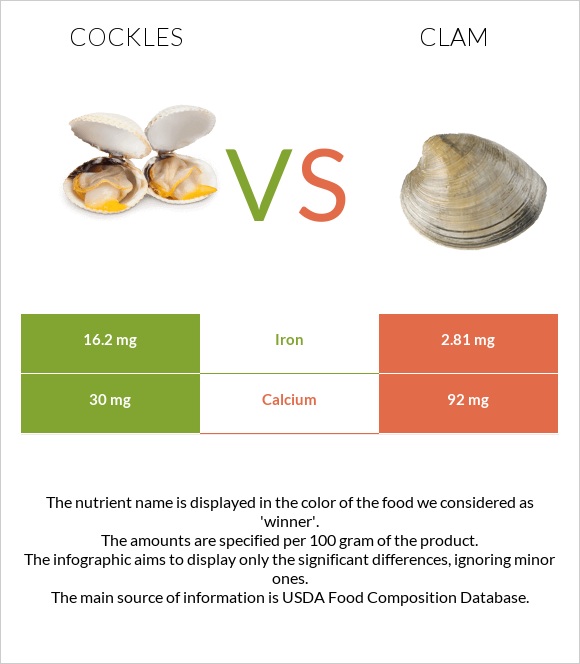Cockles vs. Clam — In-Depth Nutrition Comparison
Compare
What are the differences between cockles and clam?
- Cockles are higher in iron; however, clam is richer in vitamin B2, vitamin B1, and calcium.
- Cockles' daily need coverage for iron is 167% more.
We used Cockles, raw (Alaska Native) and Mollusks, clam, mixed species, cooked, moist heat types in this article.
Infographic

Infographic link
Mineral Comparison
Mineral comparison score is based on the number of minerals by which one or the other food is richer. The "coverage" charts below show how much of the daily needs can be covered by 300 grams of the food.
| Contains more IronIron | +476.5% |
| Contains less SodiumSodium | -100% |
| Contains more CalciumCalcium | +206.7% |
Vitamin Comparison
Vitamin comparison score is based on the number of vitamins by which one or the other food is richer. The "coverage" charts below show how much of the daily needs can be covered by 300 grams of the food.
| Contains more Vitamin B1Vitamin B1 | +1400% |
| Contains more Vitamin B2Vitamin B2 | +113% |
All nutrients comparison - raw data values
| Nutrient |  |
 |
DV% diff. |
| Vitamin B12 | 98.89µg | 4120% | |
| Iron | 16.2mg | 2.81mg | 167% |
| Selenium | 64µg | 116% | |
| Copper | 0.688mg | 76% | |
| Sodium | 1202mg | 52% | |
| Phosphorus | 338mg | 48% | |
| Manganese | 1mg | 43% | |
| Vitamin C | 22.1mg | 25% | |
| Zinc | 2.73mg | 25% | |
| Protein | 13.5g | 25.55g | 24% |
| Cholesterol | 67mg | 22% | |
| Vitamin A | 171µg | 19% | |
| Potassium | 628mg | 18% | |
| Vitamin B2 | 0.2mg | 0.426mg | 17% |
| Vitamin B5 | 0.68mg | 14% | |
| Vitamin B1 | 0.01mg | 0.15mg | 12% |
| Vitamin B6 | 0.11mg | 8% | |
| Folate | 29µg | 7% | |
| Calcium | 30mg | 92mg | 6% |
| Magnesium | 18mg | 4% | |
| Polyunsaturated fat | 0.552g | 4% | |
| Calories | 79kcal | 148kcal | 3% |
| Fats | 0.7g | 1.95g | 2% |
| Vitamin B3 | 3.2mg | 3.354mg | 1% |
| Saturated fat | 0.188g | 1% | |
| Net carbs | 4.7g | 5.13g | N/A |
| Carbs | 4.7g | 5.13g | 0% |
| Monounsaturated fat | 0.172g | 0% | |
| Tryptophan | 0.286mg | 0% | |
| Threonine | 1.099mg | 0% | |
| Isoleucine | 1.112mg | 0% | |
| Leucine | 1.798mg | 0% | |
| Lysine | 1.909mg | 0% | |
| Methionine | 0.576mg | 0% | |
| Phenylalanine | 0.915mg | 0% | |
| Valine | 1.116mg | 0% | |
| Histidine | 0.49mg | 0% | |
| Omega-3 - EPA | 0.138g | N/A | |
| Omega-3 - DHA | 0.146g | N/A | |
| Omega-3 - DPA | 0.104g | N/A |
Macronutrient Comparison
Macronutrient breakdown side-by-side comparison
| Contains more WaterWater | +23.8% |
| Contains more ProteinProtein | +89.3% |
| Contains more FatsFats | +178.6% |
| Contains more OtherOther | +62.2% |
~equal in
Carbs
~5.13g


